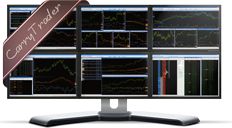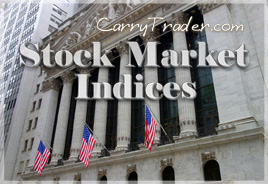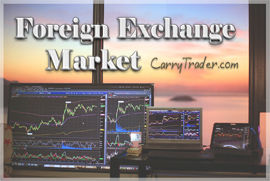Forecasting Market’s Volatility using two CBOE Volatility Indexes (VIX & Skew Index)
Options volatility indexes are used in forecasting future market volatility and the investor sentiment. The analysis of such volatility measures may assist investors managing and diversifying their portfolio more effectively.
In this analysis, two (2) important market volatility barometers are presented, both calculated based on the volatility of CBOE options:
- CBOE Volatility Index (^VIX)
- CBOE Skew Index (^SKEW)
The CBOE includes several other volatility indexes on stock indices, ETFs, shares, commodities, and tradable volatility contracts (VIX options, VIX futures, etc.). At the end of this analysis, you may find the full range of CBOE volatility indexes.
(1) CBOE Volatility Index (^VIX)
The CBOE Volatility Index (VIX) is considered the most important barometer of equity market volatility. The VIX Index is based on options contracts, on the S&P 500 Index (SPX). It is designed to reflect investors' consensus view of 30-day expected stock market volatility.
The Role of Options Volatility as a Forecasting Tool
The price of the call and put options can be used to calculate implied volatility because volatility is one of the factors used to calculate the value of these options. Any volatility modification of the underlying instrument makes an option contract more (or less) valuable, as there is a greater (or smaller) probability that the option may expire in-the-money, at the end of its maturity.
■ The Greater the Options Volatility → the Greater the Option Price -Therefore, other things being equal, a higher option price incurs greater volatility.
Note: The other two main factors when pricing an option, except volatility, include intrinsic value and time to maturity.
VIX Interpretation
VIX is quoted in percentage points and translates, roughly, to the expected movement (with the assumption of a 68% likelihood i.e. one standard deviation) in the S&P 500 index over the next 30-day period, which is then annualized.
■ Example (based on CBOE guide):
If VIX is 15, this represents an expected annualized change, with a 68% probability, of less than 15% over the next 30 days; thus one can infer that the index options markets expect the S&P 500 to move up or down 15%/√12 = 4.33% over the next 30-day period. That is, index options are priced with the assumption of a 68% likelihood (one standard deviation) that the magnitude of the change in the S&P 500 in 30 days will be less than 4.33% (up or down).
VIX Calculation
The CBOE VIX Index is a volatility index comprised of options rather than stocks. This is the generalized formula used in the VIX calculation:

(2) CBOE Skew Index (^SKEW)
CBOE Skew Index measures the implied volatility of deep out-of-the-money options. Deep out-of-the-money options are options contracts that are not profitable:
■ Deep out-of-the-money options, mean a great difference between the Current Price and the Price of Execution of the Underlying Instrument. This difference is producing a highly Negative Intrinsic Value.
The CBOE Skew IndexSM or "SKEW" – is an option-based indicator that measures the perceived tail risk of the distribution of S&P 500 returns at a 30-day horizon.
CBOE Skew Interpretation
The CBOE Skew Index works as a measure of panic, in the Equity Markets. As concerns the S&P500, there have been 15 times in the past when the CBOE Skew Index readings moved above 140, during the period 1990-2015. 12 of those 15 times have been in the last two years (2013-2015). An explanation for the increase in the Skew Index spikes is the increase in the cost of hedging during the past couple of years.

SKEW Calculation
SKEW is derived from the price of S&P 500 skewness. That price is calculated from the prices of S&P 500 options using the same type of algorithm as for the CBOE Volatility Index (VIX).
SKEW typically ranges from 100 to 150. The skew value of 100 means that the perceived distribution of S&P 500 log-returns is normal and the probability of outlier returns is therefore negligible. As SKEW rises above 100, the left tail of the S&P 500 distribution acquires more weight, and the probabilities of outlier returns become more significant.
Other CBOE Volatility Indexes
The Chicago Board Options Exchange (CBOE) calculates and updates the values of about 30 indexes based on the expected volatility of different securities.
■ Volatility Indexes (Currency Futures)
- CBOE/CME FX Euro Volatility Index EUVIX, -Link: » www.cboe.com/FX
- CBOE/CME FX Yen Volatility Index JYVIX, -Link: » www.cboe.com/FX
- CBOE/CME FX British Pound Volatility Index BPVIX, -Link: » www.cboe.com/FX
■ Volatility Indexes (Interest Rates)
- CBOE/CBOT 10-year U.S. Treasury Note Volatility Index TYVIX, -Link: » www.cboe.com/TYVIX
- Interest Rate Swap Volatility Index SRVX, -Link: » www.cboe.com/SRVX
■ Volatility Indexes (Stock Indexes)
- Volatility Index VIX, -Link: » www.cboe.com/VIX
- Skew Index, -Link: » www.cboe.com/Skew
- S&P 100 Volatility Index VXO, -Link: » www.cboe.com/VXO
- Nasdaq-100 Volatility Index VXN, -Link: » www.cboe.com/VXN
- DJIA Volatility Index VXD, -Link: » www.cboe.com/VXD
- Russell 2000 Volatility Index RVX, -Link: » www.cboe.com/RVX
- 3-Month Volatility Index VXV, -Link: » www.cboe.com/VXV
- Mid-Term Volatility Index VXMT, -Link: » www.cboe.com/VXMT
■ Volatility Indexes (ETFs)
- Crude Oil Volatility Index OVX, -Link: » www.cboe.com/OVX
- Gold Volatility Index GVZ, -Link: » www.cboe.com/GVZ
- EuroCurrency Volatility Index EVZ, -Link: » www.cboe.com/EVZ
- EFA ETF Volatility Index VXEFA, -Link: » www.cboe.com/VXEFA
- Emerging Markets ETF Volatility Index VXEEM, -Link: » www.cboe.com/VXEEM
- China ETF Volatility Index VXFXI, -Link: » www.cboe.com/VXFXI
- Brazil ETF Volatility Index VXEWZ, -Link: » www.cboe.com/VXEWZ
- Silver ETF Volatility Index VXSLV, -Link: » www.cboe.com/VXSLV
- Gold Miners ETF Volatility Index VXGDX, -Link: » www.cboe.com/VXGDX
- Energy Sector ETF Volatility Index VXXLE, -Link: » www.cboe.com/VXXLE
■ Volatility Indexes (Single Stocks)
- VIX on Amazon VXAZN, -Link: » www.cboe.com/VXAZN
- VIX on Apple VXAPL, -Link: » www.cboe.com/VXAPL
- VIX on Goldman Sachs VXGS, -Link: » www.cboe.com/VXGS
- VIX on Google VXGOG, -Link: » www.cboe.com/VXGOG
- VIX on IBM VXIBM, -Link: » www.cboe.com/VXIBM
■ Volatility of VIX
- CBOE VIX of VIX Index VVIX, Link: » www.cboe.com/VVIX
MORE ON CARRYTRADER
| ■ COMPARE PROVIDERS | ► Brokers for Carry Traders | |||||
| ■ FOREX RESOURCES | » Currency indices | » Currency Pairs | » Forex Fundamentals | » Trading Naked Charts & Strategies | ||
| ■ OTHER RESOURCES | » CBOE Indices | » Famous Investors |
■ CBOE Volatility Index & CBOE Skew Index
George Protonotarios for CarryTrader.com (c)










